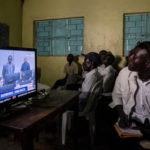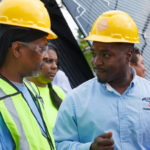| by Lindsay Benedict, IMD Contributor One primary way to develop women leaders is to have women act as role models and mentors. And in three particular careers known for providing guidance – the priest, the university president, the opinion columnist, three women are doing just that. Women today expect to choose the gender of their mentors and those they interact with, something the generations before us were not always able to do. For example, Dr. Elsa-Grace Giardina, professor of medicine and director of Columbia Presbyterian Center for Women’s Health, says that women who are given a choice vocally prefer female doctors. “It’s generational,” she said. “There is a larger pool of expert women today,” and we tend to want to connect with them. The First Female Catholic Priest?Catholic parishioners often depend on a priest for counseling and spiritual guidance. Yet, in the Catholic institution, women do not have a choice in the gender of their priest, leading to a lack of diversity in perceptions of the world. One woman has decided to try to change this and applied for admission to study for the Catholic priesthood in 1996. Susan Rockwell from Hanover, NH wants to become an ordained Catholic priest. She applied to Manchester Bishop Leo O’Neil for admission, but her application was rejected because of church policy. Rockwell, a practicing attorney in Vermont, claims the church’s refusal to ordain women amounts to sexual discrimination. Last May, she filed a lawsuit in U.S. District Court against the Roman Catholic Church, saying it must ordain women as priests or forfeit its federal tax exempt status. Rockwell said that by granting the church tax exempt status, the federal government subsidizes the church’s discriminatory policies. Father Pat McCloskey, editor of the American Catholic Organization said the Catholic Church’s ability to set criteria for those preparing for ordination cannot be overturned by a gender discrimination lawsuit. “Pope John Paul II has been very clear that the Catholic Church does not see itself free to ordain women to the Sacrament of Holy Orders.” Currently, women can head state, regional, national or international Catholic organizations. “The worldwide minister of the Secular Franciscan Order, for example, is a woman,” said Father McCloskey. “If she wanted to get into Weston School of Theology (Cambridge, MA), she would not have to sue to be admitted. Many women study there.” Rockwell has a slim chance of becoming a priest, but her effort is mirrored throughout the society. Women are demanding to confide in and work with other women. Ivory Towers Full of WomenIn 2001, twenty-two percent of university presidents were women and that number is still increasing, perhaps as a result of a January 2002 report in which nine major research universities jointly acknowledged unintended barriers to the advancement of women faculty. (See Top Schools Are Pursuing Pledge to Redress Bias.) An effect has been more women working together at higher level positions.At Princeton University, Shirley M. Tilghman became the first woman to be president of the institution. A week later, she named a woman as provost and in May, she named a woman as dean of the Woodrow Wilson School. And just recently, without fanfare, she named a woman as dean of the School of Engineering and Applied Science. With a woman already in place as dean of the undergraduate college and appointed to another five-year term — that puts women in more than half of Princeton’s top academic jobs — little more than three decades after Princeton first admitted women as undergraduates. Claire van Ummersen, vice president and director of the office of women in higher education at the American Council on Education (ACE), said women have been waiting to work with women bosses. “Women in the [academic] pipeline who are prepared and ready want to work with the new female presidents,” said van Ummersen. She said women desperately want to work with other qualified women and will seek them out. “Women work harder to identify good women. They call their friends, they make certain the information reaches women, and they go after them.” The National Initiative for Women in Higher Education is a grassroots network whose members believe that not only have women created fundamental change in American higher education over the past 30 years, but they are now also in a position to carry it to the next stage. One particular way they hope to accomplish this is by “actively recruit[ing], hir[ing]/appoint[ing] women, particularly women of color, of various ages and sexual orientations, to key leadership positions and provide programs to support their success.” Chair of the National Initiative and Duke University’s assistant vice president in the office of the executive vice president, Judith White, said that women presidents are no longer unusual; she had been working with a few women who were vice presidents at the time and are now presidents. “Women’s networks have become stronger,” said White. “I knew that Nannerl Keohane (Duke’s president) was a strong leader when I interviewed with her.” Women are still developing an understanding of their strengths in leadership roles. Jill Kerr Conway, first female president of Smith, writes in A Woman’s Education, “But as with all other political movements, 1970s feminism wasn’t monolithic… Most of this younger generation could be mobilized around a small segment of feminist issues, but on all others they espoused radically different strategies for change. All expected that Smith’s first woman president would see things their way.” Opinion Columnists and Journalists -Women’s Voices HeardAs the International Women’s Media Foundation explains:
And, although this power in large part is still in men’s hands, there are women who are clearly gaining our attention and becoming role models for the opinions and news they share. However, the word ‘opinion’ is deceiving. Only established writers have the authority to write opinion columns. Columnists must prove themselves as respectable voices through awards, degrees, and long-term performance. Take for instance Maureen Dowd, an op-ed columnist for the New York Times. She served as a correspondent in the Washington bureau since 1986, and only after nine years of earned her way to the op-ed pages. Winner of the 1999 Pulitzer Prize for distinguished commentary, she has the green light to write her controversial perspective on the personal and political issues relating to women in the 21st century. Opinion columnists are the leading mirrors in society. They expose issues just as they are allowed to be spoken of. In Dowd’s article ‘Barbie Loves Math’ she writes, “Only ten years after Mattel put out ‘Teen Talk Barbie’ whining ‘Math class is tough,’ we have women unearthing the Rosetta stone of [Enron’s] indecipherable scandal…Some men suggest that women, with their vast experience with male blarney, are experts at calling guys on it.” And then, too, there are journalists such as CNN’s Christian Armanpour, who are vigorously reminding us that we have voices that should be heard. Armanpour began her career as a reporter, anchor, and producer for WBRU-Radio, in Providence in the early 1980s and moved to CNN as a desk assistant in 1983. In the late 1980s she began. reporting on the changes occurring in central Europe and for the last decade, we have seen her face and heard her words almost nightly. Women are showing by example, by becoming notable role models. In doing so, they are opening the paths for other women. |
||
|











